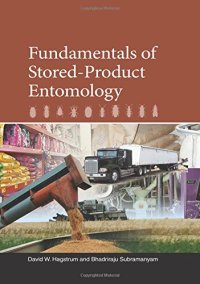
Ebook: Fundamentals of Stored-Product Entomology
- Tags: Biotechnology, Biological Sciences, Science & Math, Science & Mathematics, Agriculture, Astronomy & Astrophysics, Biology & Life Sciences, Chemistry, Earth Sciences, Environmental Studies, Mathematics, Mechanics, Physics, New Used & Rental Textbooks, Specialty Boutique
- Year: 2008
- Publisher: Amer Assn of Cereal Chemists
- Language: English
- pdf
This new reference discusses the fundamentals of stored-product entomology that need to be considered in planning, implementation, and evaluation of a pest management program. It is based on the review of an extensive database of references and many years of research on stored-product insect problems by the expert authors. With recent regulatory changes, consumers concern about pesticide residues in food, and food companies embracing IPM and alternative approaches for pest management, this book is timely. It provides the basic information needed to manage pests with and without the use of chemicals.
Managing pests requires a thorough understanding of insect biology, behavior, ecology, sampling, pros and cons of management options, and responses of insects to the various management options. This comprehensive book covers all of these topics, beginning with a discussion of the scope of stored-product entomology. It also provides insight into the diversity of foods and habitats utilized by stored-product insects, the types of economic losses attributable to them, and the ways in which an understanding of their biology can be used to study or manage these insects. Insect mobility, sources of insect infestation, sampling, life history, and population growth are discussed as well, as they play an important role in developing an effective sampling program. In addition, decision aids, the cost of management methods, and the resistance of insects to management methods are covered.
For insight into the thought process of choosing treatment options, eight pest management methods are thoroughly described, including a statement of the basic operating principle and background information. For help choosing various chemical and nonchemical methods for diverse situations, the advantages, disadvantages and implementation options for each method are given. Students, extension educators, consultants, food industry sanitarians and managers, legislators, regulators, and insect pest management professionals are sure to find information that will help them to improve pest management.
Excellent teaching tool!
Study questions at the end of each chapter
Suggested supplemental reading, including books, conference proceeding papers, literature reviews, research papers, government publications, and popular articles
General overview of the biology for a basic understanding of pest control issues
Guides the reader through the thought process of designing a pest control program or research study
Images of the most damaging of stored-product insect pest species for identification of families
Quick methods for distinguishing closely related stored-product insect species
Managing pests requires a thorough understanding of insect biology, behavior, ecology, sampling, pros and cons of management options, and responses of insects to the various management options. This comprehensive book covers all of these topics, beginning with a discussion of the scope of stored-product entomology. It also provides insight into the diversity of foods and habitats utilized by stored-product insects, the types of economic losses attributable to them, and the ways in which an understanding of their biology can be used to study or manage these insects. Insect mobility, sources of insect infestation, sampling, life history, and population growth are discussed as well, as they play an important role in developing an effective sampling program. In addition, decision aids, the cost of management methods, and the resistance of insects to management methods are covered.
For insight into the thought process of choosing treatment options, eight pest management methods are thoroughly described, including a statement of the basic operating principle and background information. For help choosing various chemical and nonchemical methods for diverse situations, the advantages, disadvantages and implementation options for each method are given. Students, extension educators, consultants, food industry sanitarians and managers, legislators, regulators, and insect pest management professionals are sure to find information that will help them to improve pest management.
Excellent teaching tool!
Study questions at the end of each chapter
Suggested supplemental reading, including books, conference proceeding papers, literature reviews, research papers, government publications, and popular articles
General overview of the biology for a basic understanding of pest control issues
Guides the reader through the thought process of designing a pest control program or research study
Images of the most damaging of stored-product insect pest species for identification of families
Quick methods for distinguishing closely related stored-product insect species
Download the book Fundamentals of Stored-Product Entomology for free or read online
Continue reading on any device:

Last viewed books
Related books
{related-news}
Comments (0)